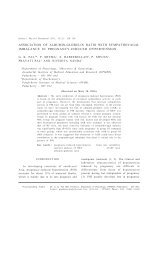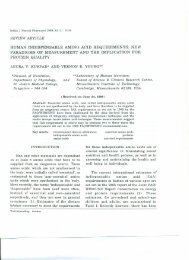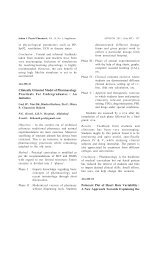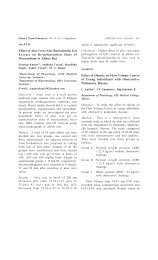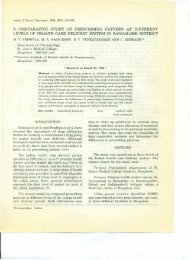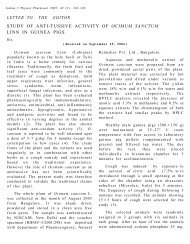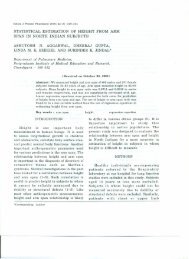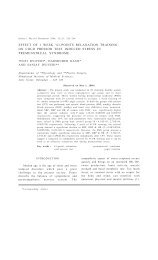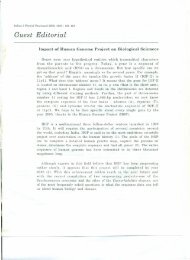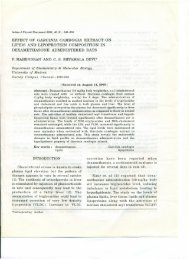COMMENTS ON THE ARTICLES ON YOGA
COMMENTS ON THE ARTICLES ON YOGA
COMMENTS ON THE ARTICLES ON YOGA
Create successful ePaper yourself
Turn your PDF publications into a flip-book with our unique Google optimized e-Paper software.
Indian J Physiol Pharmacol1993; 37(4): 350-352<br />
LEITERS<br />
TO <strong>THE</strong> EDITOR<br />
<strong>COMMENTS</strong> <strong>ON</strong> <strong>THE</strong> <strong>ARTICLES</strong> <strong>ON</strong> <strong>YOGA</strong><br />
Sir,<br />
( Received on 28, January 1993 )<br />
I would like to comment on three articles on<br />
yoga published recently in UPP.<br />
Regarding the article on the effect of yoga on<br />
reaction time, respiratory endurance and muscular<br />
strength (1) :<br />
1. The names of asanas like Navasan, Navkasan<br />
and Mukhabhastrika are not mentioned anywhere in<br />
the traditional texts on yoga.<br />
2. The duration of 18 yoga exercises was 30 min<br />
and the total practice session was also held for 30 min.<br />
How was this done? Was there no interval at all between<br />
exercises?<br />
3. A control group should have been studied and<br />
matched for such parameters which are dependent upon<br />
age and since the pre and post measurements are<br />
separated by 3 months.<br />
Regarding the letter on heart rate alterations in<br />
parnayamas (2) :<br />
1. Names of Pranayama have no traditional<br />
support from ancient texts, except Nadisuddhi<br />
Pranayama. The readers will therefore have no idea<br />
about the technique of Vibhaga, Mahat Yoga and Savitri<br />
Pranayama.<br />
2. If a person is well trained and has been practising<br />
for 4 years, heart rate should not increase so much.<br />
Marginal increase of 5 to 7 beats/ruin is understandable.<br />
That means the present subject was practising with<br />
muscular exertion.<br />
3. The ratios given for Vibhaga and Mahat yoga<br />
are objectionable; i.e., 1:1:0.20 and 1:1:0.25 respectively.<br />
The traditional ratios are 1:2:2, 1:4:2 (Hathapradipika)<br />
and 6:8:5 (Goraksha Samhita Ch. II:4) for Purak,<br />
Kumbhak and Rechak.<br />
Regarding the letter on heart rate and respiratory<br />
changes accompanying single thought and thoughless<br />
states (3) :<br />
1. How did the investigator confirm whether the<br />
subject was really in "single thought" or "no thought"<br />
state of mind? Thoughtless condition is almost difficult<br />
to achieve since it is related to the degree of arousal of<br />
the brain.<br />
2. From the respirogram it appears that the subject<br />
was not in the "No thought" state because mainly the<br />
expiratory phase of the respiratory cycle is seen<br />
disturbed, indicating cortical interference in the<br />
autonomic function. In single thought at least it is<br />
minimum.<br />
3. The scale of 20 see given in the graph and rate<br />
of respiration given in the Table do not correspond.<br />
From the scale it seems to be 12/min in normal, 8/min<br />
in the first single thought state (upper line), lO/min in<br />
next single thought state (third line) and 7 to l l/min in<br />
'no thought' state. Increased respiratory rate and<br />
decreased amplitude indicate sympathetic predominance<br />
and an anxious state of mind.<br />
M.M.GORE<br />
Scientific Research Department.<br />
Kaivalyadhama,<br />
Lonavla - 410 403<br />
I-<br />
REFERENCES<br />
I. Madanmohan, Thombre OP. Balakumar B. Nambinarayanan<br />
TK. Thakur S, Krishnamurthy N, Chandrabose A. Effect of<br />
yoga training on reaction time, respiratory endurance and muscle<br />
strength. Indian J Physiol Pharmacol 1992; 36: 229-233.<br />
2. Telles S, Desiraju T. Heart rate alterations in different types of<br />
pranayamas.lndian J Physiol PharmJJcol1992; 36: 287-288.<br />
3. Telles S, Desiraju T. Heart rate and respiratory changes accompanying<br />
yogic conditions of single thought and thoughtless<br />
states. Indian J Physiol Pharmacol 1992; 36: 293-294.
Indian J Physiol Pharmacol 1993; 37(4)<br />
Letter to the Editor 351<br />
DR. MADANMOHAN'S REPLY<br />
( Received on April 10, 1993 )<br />
Sir,<br />
We are thankful to Dr. Gore for his reaction to<br />
our paper (1). We give our point-by-point response to<br />
his comments.<br />
1. The techniques of Navasan, Navakasan and<br />
Mukhabhastrika are given on pages 80, 76 and A- 77<br />
respectively of "Yoga: Step-by-step" by Gitananda<br />
Swami (2). Yogeswar describes Navasan as naukasanasupine<br />
and Navakasan as Naukasana-prone (3).<br />
Navakasan is described as Naukasan in Yogasan Vijnan<br />
by Dhirendra Brahmachari (4). We have followed the<br />
method and terminology given by Gitananda Swami<br />
(2). In brief, Navasan is assumed from the supine position<br />
by raising the upper part of the body and the legs on<br />
an incoming breath so that the toes are in line with the<br />
nose. The resultant boat-like posture is maintained for<br />
the required duration. Navakasan is the opposite posture<br />
of Navasan and is assumed from the prone position.<br />
Mukhabhastrika, a bellows type breathing is done by<br />
taking in a full breath and blasting out the air in short,<br />
repetitive 'whooshes' while the lips are pused (in 'kaaki<br />
mudraa').<br />
2. The different yoga techniques followed each<br />
other without any rest period between them. An interval<br />
of a few seconds between the postures does not make<br />
any significant difference.<br />
3. We agree that it would have been ideal to<br />
have a control group. However, while one can have<br />
any number of experimental animals like rats, it is<br />
difficult to get healthy, cooperating volunteers for control<br />
study. The period of yoga training was only 3 months<br />
and the subjects formed their own control. Hence a<br />
separate control group was not incorporated. The<br />
magnitude of changes observed in our study is so large<br />
that these cannot be attributed to factors other than the<br />
experimental intervention which was yoga in the present<br />
study. We do not expect changes in reaction time,<br />
respiratory pressures and breath holding time with<br />
increase in age (3 months in our study).<br />
MADANMOHAN<br />
Department of Physiology,<br />
lIPMER, Pondicherry - 605 006<br />
REFERENCES<br />
1. Madanmohan, Thombre DP, Balakumar B, Nambinarayanan<br />
TK, Thakur S, Krishnamurthy N, Chandrabose A. Effect<br />
of yoga training on reaction time, respiratory endurance and<br />
muscle strength. Indian J Physiol Pharmacol 1992; 36: 229-<br />
233.<br />
2. Gitananda Swami. Yoga: step-by-step. Pondicherry: Satya<br />
Press, 1981: 4-229.<br />
3. Yogeswar. Textbook of Yoga. Madras: Yoga Centre, 1982:<br />
91-433.<br />
4. Dhirendra Brahmchari. Yogasan Vijnan (Hindi). New Delhi:<br />
Dhirendra Yoga Prakashan, 1966: 117.
352 Leuer to the Editor<br />
Indian] Physiol Phannacol 1993; 37(4)<br />
DR. TELLES'S<br />
REPLY<br />
( Received on April 12, 1993 )<br />
Sir,<br />
Regarding our letter on heart rate alterations in<br />
pranayamas (1):<br />
1. Pranayama has been described as voluntary<br />
regulation of breathing (more often slowing down) which<br />
ultimately achieves a calm state of mind. In Savitri<br />
pranayama the subject strives to regulate the ratios<br />
(inhale : End-inspiratory Kumbhak : expiration:<br />
end-expiratory Kumbhak) as 2:1:2:1. In Mahat Yoga<br />
and Vibhaga pranayamas there is virtually no emphasis<br />
on the ratios. Breathing is expected to be slow and<br />
rhythmic.<br />
We found that the pattern was consistent and there<br />
was no attempt to consciously regulate it In Mahatyoga<br />
the mind was allowed to be engaged in thoughts of<br />
union of self with the Supreme, whereas in Vibhaga<br />
Pranayama the attention was focussed on three different<br />
(imaginary) sectors of the lungs i.e. upper, middle, and<br />
lower.<br />
2. It is possible that in spite of having more than<br />
five years' experience, the subject was practising<br />
Pranayama with muscular exertion.<br />
3. As mentioned in the first response Vibhaga<br />
and Mahat Yoga Pranayamas were not similar to the<br />
traditional pranayamas (with ratios 1:2:2 or 1:4:2).<br />
Regarding ~ letter on heart rate and respiratory<br />
changes accompanying single thought and thoughtless<br />
states (2) :<br />
1. Studies by Roland and Friberg (3) have<br />
reported changes in regional cerebral blood flow with<br />
different types of targetted thinking (e.g. mentally<br />
tracing a route or repeating silently a meaningless<br />
jingle). In the absence of such facilities, other<br />
measures such as recording the cerebral evoked<br />
potentials would have given only a very gross neural<br />
correlate of the state of thinking since the neural<br />
generators of middle and long latency evoked potentials<br />
are still poorly understood. Hence, in the study reported,<br />
We relied wholly on the subjective report of the Yoga<br />
practitioner.<br />
2. The comment "because mainly the expiratory<br />
phase of respiratory cycle is seen disturbed, indicating<br />
cortical interference in autonomic function" is not<br />
entirely logical. Voluntary control can be expected to<br />
alter either the inspiratory and/or the expiratory phase<br />
of respiration. Quite apart from this, it is reasonable to<br />
assume that changes in neural activity related to thinking<br />
(or a thoughtless state) would influence other parts of<br />
the brain, and possibly alter the respiration. It would<br />
be very unusual to expect that a 'no thought state'<br />
would occur simultaneously with an absence of cerebral<br />
activity.<br />
3. It may be pointed out that the graph gave only<br />
one representative sample of the respirogram recorded<br />
during 'no thought' and 'single thought' states. In<br />
contrast, values shown in the Table were mean values<br />
±S.D.<br />
SHIRLEY TELLES<br />
Vivekananda Kendra Yoga Research Foundation,<br />
Banga/ore - 560 018<br />
REFERENCES<br />
1. Telles S, Desiraju T. Heart rate alterations in different types of<br />
pranayamas.lndian J Physiol PharmacoI1992; 36: 287-288.<br />
2. Telles S, Desiraju T. Heart rate and respiratory changes<br />
accompanying yogic conditions of single thought<br />
and thoughtless states. Indian J Physiol Pharmacal 1992; 36:<br />
293-294.<br />
3. Roland PE, Friberg L. Localisation of cortical areas activated by<br />
thinking. J Neurophysiol1985; 53: 1219-1243.



